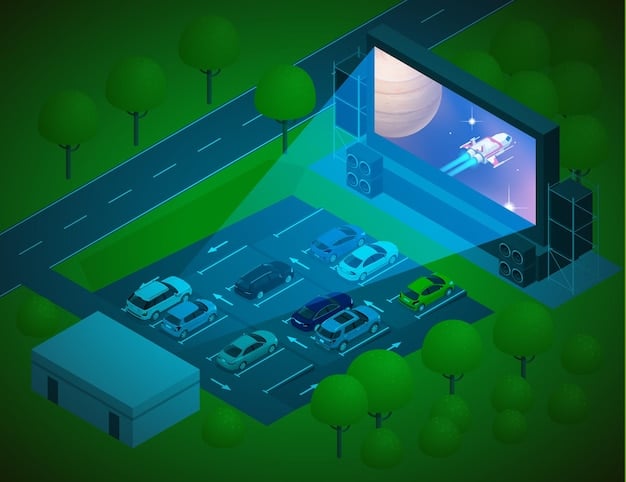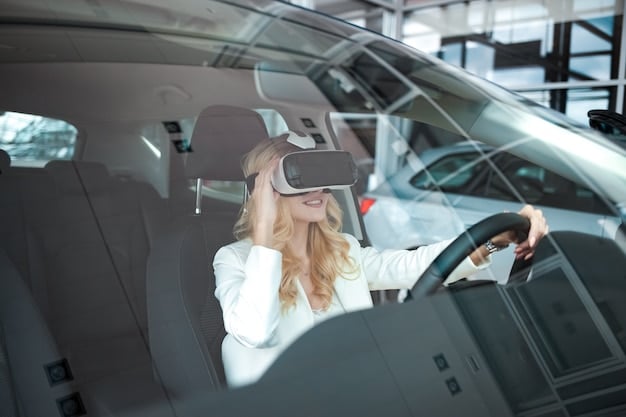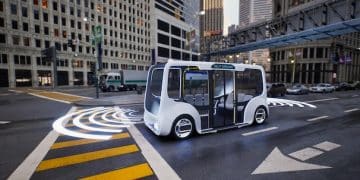Simulation in Autonomous Vehicle Testing and Validation in the US

Simulation plays a crucial role in the testing and validation of autonomous vehicles in the US, offering a safe, cost-effective, and efficient way to assess vehicle performance across a wide range of scenarios before real-world deployment.
The advent of autonomous vehicles (AVs) promises to revolutionize transportation, but ensuring their safety and reliability is paramount. The Role of Simulation in Autonomous Vehicle Testing and Validation in the US is becoming increasingly critical, offering a virtual environment to rigorously assess AV performance before they hit public roads.
The Importance of Simulation for AV Testing
Simulation is a cornerstone of autonomous vehicle development, providing a virtual testing ground that complements real-world trials. This approach allows developers to subject AVs to a multitude of scenarios, including edge cases and hazardous conditions, in a controlled and repeatable manner.
Safety and Risk Mitigation
One of the primary advantages of simulation is the ability to test AVs in potentially dangerous situations without risking human lives or causing property damage. This includes scenarios such as sudden pedestrian crossings, adverse weather conditions, and unexpected equipment failures.
Cost-Effectiveness
Real-world testing can be expensive, requiring significant resources for vehicle maintenance, fuel, and personnel. Simulation offers a more cost-effective alternative, allowing developers to conduct extensive testing without incurring these high costs.
- Reduces the need for physical prototypes and real-world mileage.
- Enables rapid iteration and testing of different algorithms and control strategies.
- Provides comprehensive data and analytics for performance evaluation.
Simulation allows for a comprehensive and repeatable testing regime, crucial for the validation of autonomous vehicle systems. By meticulously evaluating the performance of AVs in a wide array of virtual scenarios, engineers can identify potential weaknesses and refine their designs to ensure safer and more reliable operation on public roads.
Types of Simulation Environments
Various simulation environments are employed in AV testing, including those based on virtual reality (VR), augmented reality (AR), and mixed reality (MR). Each type offers unique advantages and is suited to different testing needs.

Virtual Reality (VR) Simulation
VR simulations create entirely digital environments that allow AVs and their components to be tested in a highly controlled setting. This approach is particularly useful for evaluating sensor performance and decision-making algorithms.
Augmented Reality (AR) Simulation
AR simulations overlay digital information onto the real world, allowing AVs to interact with virtual objects and scenarios in a physical context. This can be useful for testing perception systems and navigation algorithms in realistic environments.
- Enhances the realism of testing by integrating virtual elements with the real world.
- Allows for testing of AVs in complex urban environments with virtual pedestrians and traffic.
- Enables the evaluation of AV responses to dynamic and unpredictable situations.
By leveraging VR and AR in simulation, developers can create highly realistic and detailed environments for testing and refining autonomous vehicle systems, ensuring they are prepared for the challenges of real-world deployments.
Key Simulation Technologies and Tools
Several software and hardware tools are essential for effective AV simulation. These technologies enable the creation of accurate and realistic virtual environments and facilitate the analysis of AV performance.
Software Platforms
Software platforms such as CARLA, VTD, and rFpro provide comprehensive simulation capabilities, including realistic sensor models, vehicle dynamics, and traffic simulation. These tools also offer APIs for integrating custom algorithms and control strategies.
Hardware-in-the-Loop (HIL) Testing
HIL testing involves connecting physical hardware components, such as sensors and control units, to a simulation environment. This allows for real-time testing of hardware performance and integration with software algorithms.
- Provides a realistic testing environment for individual hardware components.
- Allows for early detection of hardware-software integration issues.
- Enables comprehensive testing of AV systems under various operating conditions.
The rapid advancements in simulation technologies are constantly improving the accuracy and realism of virtual testing environments. These improvements are critical for ensuring that autonomous vehicles are thoroughly tested and validated before being deployed on public roads.
Regulatory Framework and Standards
Government agencies and industry organizations are developing regulatory frameworks and standards to ensure the safety and reliability of autonomous vehicles. Simulation plays a crucial role in meeting these requirements by providing a standardized and verifiable testing methodology.

NHTSA Guidelines
The National Highway Traffic Safety Administration (NHTSA) has issued guidelines for AV testing and deployment, emphasizing the importance of simulation in validating AV safety and performance. These guidelines provide a framework for manufacturers to follow in developing and testing their autonomous vehicles.
SAE Standards
The Society of Automotive Engineers (SAE) has developed standards for AV testing, including simulation protocols and metrics. These standards define the minimum requirements for simulation environments and testing procedures to ensure consistent and reliable results.
By adhering to these regulatory frameworks and standards, AV developers can demonstrate that their vehicles have been rigorously tested and validated in simulation, providing assurance to regulators and the public about their safety and reliability. Simulation also serves as a tool to comply with testing requirements, ensuring AVs meet regulatory standards and are prepared for safe deployment.
Challenges and Future Directions
Despite its many benefits, simulation also faces several challenges, including the need for accurate sensor models, realistic traffic simulation, and efficient data processing. Addressing these challenges is crucial for realizing the full potential of simulation in AV testing.
Sensor Modeling
Accurate sensor models are essential for realistic simulation. These models must accurately replicate the behavior of real-world sensors, including their limitations and potential failure modes. This requires ongoing research and development to improve the fidelity of sensor models.
Traffic Simulation
Realistic traffic simulation is crucial for evaluating AV performance in complex and dynamic environments. This includes modeling the behavior of human drivers, pedestrians, and other vehicles, as well as simulating various traffic patterns and congestion levels.
- Improving the accuracy of traffic simulation models through real-world data collection and analysis.
- Developing algorithms for predicting and responding to unexpected traffic events.
- Creating standardized scenarios for evaluating AV performance in diverse traffic conditions.
Addressing these challenges will enable the development of more robust and reliable autonomous vehicles, ultimately leading to safer and more efficient transportation systems.
Case Studies of Simulation in AV Development
Several companies and research institutions have successfully employed simulation in their AV development programs. These case studies provide valuable insights into the practical applications and benefits of simulation.
Waymo
Waymo, a leader in autonomous vehicle technology, has extensively used simulation to test and refine its AV systems. The company has developed its own proprietary simulation environment that allows it to subject its vehicles to millions of virtual miles each year.
Tesla
Tesla uses simulation to validate its autopilot and full self-driving (FSD) features. The company leverages its vast fleet of vehicles on the road to collect real-world data and use it to create realistic simulation scenarios.
These case studies demonstrate the value of simulation in accelerating the development and validation of autonomous vehicles. By leveraging virtual testing, companies like Waymo and Tesla can identify and address potential issues early in the development process, leading to safer and more reliable AVs.
| Key Point | Brief Description |
|---|---|
| 🚗AV Simulation | Virtual testing of AVs for safety and reliability. |
| 🛡️Risk Mitigation | Testing in dangerous scenarios without real-world risks. |
| 🧰Simulation Tools | Software and hardware for creating virtual environments. |
| ✅Standards & Regulations | Ensuring AV safety and reliability through testing standards. |
Frequently Asked Questions (FAQ)
▼
Simulation provides a safe and cost-effective way to test autonomous vehicles in various scenarios, including dangerous situations, without risking human lives or causing damage. It allows for more comprehensive and efficient testing compared to real-world trials.
▼
Virtual reality (VR) simulations create fully digital environments, while augmented reality (AR) simulations overlay digital information onto the real world. Mixed reality (MR) combines elements of both, offering a range of testing possibilities.
▼
Software platforms like CARLA, VTD, and rFpro offer comprehensive simulation capabilities. Hardware-in-the-loop (HIL) testing connects physical hardware components to simulation environments for real-time testing and integration.
▼
Simulation provides a standardized and verifiable testing methodology, allowing AV developers to demonstrate compliance with guidelines from agencies like NHTSA and standards from organizations like SAE, ensuring safety and reliability.
▼
Challenges include the need for accurate sensor models, realistic traffic simulation, and efficient data processing. Improving these aspects is crucial for realizing the full potential of simulation in autonomous vehicle testing and validation.
Conclusion
In conclusion, simulation is an indispensable tool in the testing and validation of autonomous vehicles in the US. By providing a safe, cost-effective, and efficient means of assessing AV performance, simulation plays a vital role in ensuring the safety and reliability of these vehicles before they are deployed on public roads, fostering innovation and responsible advancement in transportation technology.





